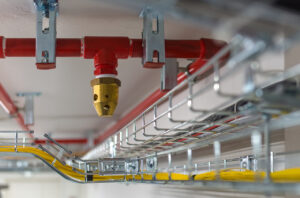Together with the HSE, the Ladder Association have launched a new guide to the safe use of ladders and stepladders. “LA455 Safe Use of Ladders and Stepladders – a brief guide” builds on the HSE’s existing similarly titled publication “INDG455 Safe Use of Ladders and Stepladders – a brief guide”.
Both publications include guidance on when a ladder should be used, selecting the right equipment, checking and using ladders safely. The new guidance however has been expanded to include guidance for telescopic ladders, combination and multi-purpose ladders.
The guidance can be downloaded from the Ladder Association’s website at: https://ladderassociation.org.uk/la455/
In addition the Ladder Association have also launched a new Code of Practice for the safe and effective use of portable ladders and stepladders, this more detailed document contains guidance on risk assessment, selecting the right ladder, pre-use checks, setting a ladder at the correct angle, using different types of ladders, looking after ladders and instructing users.
This can also be downloaded from the Ladder Association’s website at: https://ladderassociation.org.uk/wp-content/uploads/2021/07/Ladder-Association-Code-of-Practice-Version-2-Rev-0-0721.pdf
Recent figures show that falls from height continue to be the most common cause of fatal injury accounting for 34 deaths in 2020/21.
The safest option is to avoid working at height wherever possible e.g. by using extendable tools from ground level rather than climbing a ladder with normal tools. However this is not always practical, when it is necessary to carry out work at height action will need to be taken to prevent falls where possible and minimise the consequences and distance of a fall where the risk can’t be eliminated.
Some work can be safely carried out using ladders, typically such work should be low risk short duration work less than 30 minutes duration.
Where work at height is necessary the first step is to make sure that it is properly planned. When planning for work at height things to consider can include:
- Making sure that people working at height have suitable training, information and supervision;
- Weather conditions;
- Features of the work location e.g. unprotected edges, fragile surfaces, etc;
- Deciding whether it is safe and practical to carry out the work from an existing place of work or by using existing means or whether suitable work equipment will need to be provided to prevent a fall or minimise the consequences and distance of a fall;
- Providing the right equipment;
- Precautions to prevent materials or objects falling from height or if this can’t be prevented providing exclusion zones to keep people away;
- Planning for emergency situations and rescues.
Exactly what level of planning and competence is required will depend on individual circumstances. Some low risk work may just require simple precautions and on the job training, while more complex work e.g. designing and assembling scaffolding systems will require a greater degree of technical competence and training.
Please speak to your normal PIB Risk Management contact or get in touch using [email protected] if you have any questions regarding managing work at height in your workplace.

Second Staircases In New Tall Residential Buildings

A New Regime For Residential Buildings In Wales

Vibrating Alarms And Painted Cables – New Guidance Available

Two-Tyred: Driver Fatigue

New E-Bike and E-Scooter Safety Guidance for Public Transport Operators
